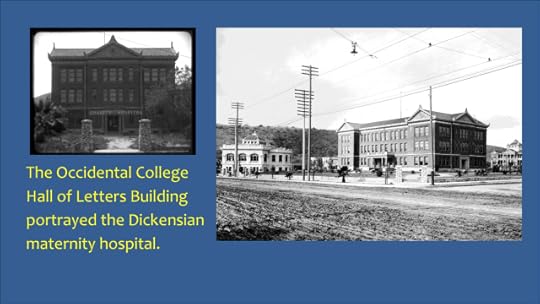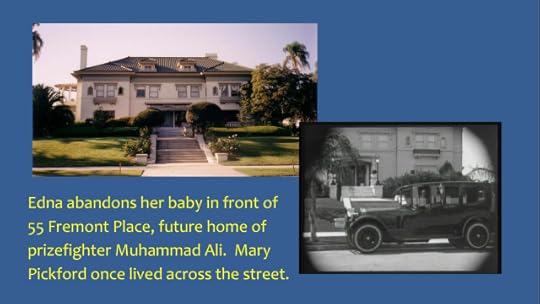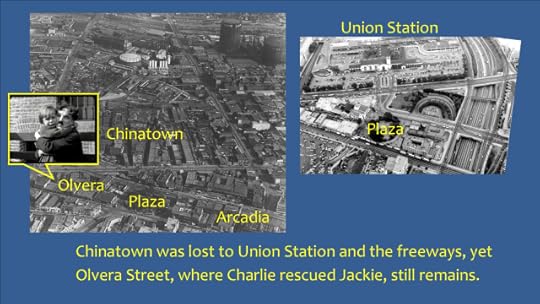John Bengtson's Blog, page 19
April 29, 2016
How Harold Lloyd Filmed Bumping Into Broadway

Looking north up Weller Street toward the tower of the former Los Angeles County Courthouse (1891-1935).
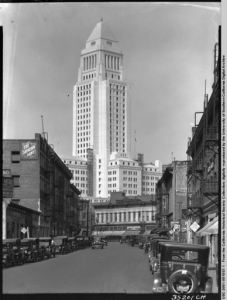 Harold Lloyd’s debut two-reel comedy featuring his ‘Glass Character,’ Bumping Into Broadway (1919), appears in a sparkling restoration as part of the new Criterion Collection Blu-ray release of Speedy (1928). Lloyd filmed many scenes in downtown Los Angeles, including Weller Street (see above), and before the Trinity Auditorium, still standing at 851 S. Grand Avenue (see below), as well as on Bunker Hill (for more details see my book Silent Visions). At right, a matching late 1920s view of Weller Street, showing how the newly completed City Hall blocks the old court house from view. USC Digital Library. Part of Japantown, Weller is renamed today ‘Astronaut E.S. Onizuka Street,’ honoring the first Asian-American to reach space, who was among the crew of the Challenger space shuttle disaster.
Harold Lloyd’s debut two-reel comedy featuring his ‘Glass Character,’ Bumping Into Broadway (1919), appears in a sparkling restoration as part of the new Criterion Collection Blu-ray release of Speedy (1928). Lloyd filmed many scenes in downtown Los Angeles, including Weller Street (see above), and before the Trinity Auditorium, still standing at 851 S. Grand Avenue (see below), as well as on Bunker Hill (for more details see my book Silent Visions). At right, a matching late 1920s view of Weller Street, showing how the newly completed City Hall blocks the old court house from view. USC Digital Library. Part of Japantown, Weller is renamed today ‘Astronaut E.S. Onizuka Street,’ honoring the first Asian-American to reach space, who was among the crew of the Challenger space shuttle disaster.
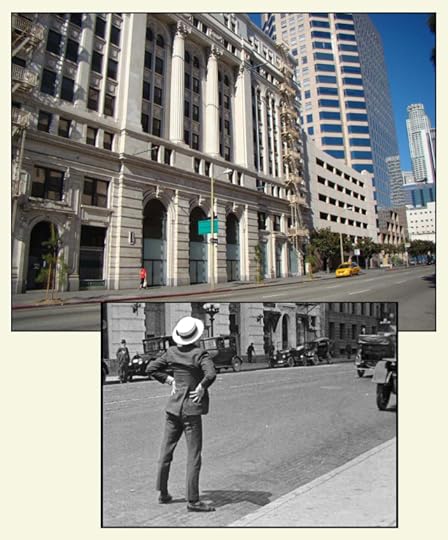
Harold on Grand Avenue before the Trinity Auditorium, 851 S. Grand Avenue.
 During an era before zoning laws were passed, you will often see homes adjacent to shops and even factories in the background of silent films. One scene early in Bumping Into Broadway had long captured my attention, as Harold jumps from a stone wall into the back of a limousine convertible. In the background are many homes, a hill, and even oil derricks (left)! I long suspected this scene was filmed to the NW of downtown, perhaps in the hills leading up to Chavez Ravine. Thanks to the remarkable clarity and resolution of the new Blu-ray release, I was finally able to track this down.
During an era before zoning laws were passed, you will often see homes adjacent to shops and even factories in the background of silent films. One scene early in Bumping Into Broadway had long captured my attention, as Harold jumps from a stone wall into the back of a limousine convertible. In the background are many homes, a hill, and even oil derricks (left)! I long suspected this scene was filmed to the NW of downtown, perhaps in the hills leading up to Chavez Ravine. Thanks to the remarkable clarity and resolution of the new Blu-ray release, I was finally able to track this down.
 At back I noticed a portion of a rooftop sign reading “ITO BROS … NERY.” I searched for ‘wineries’ in the 1918 online city directory provided by the Los Angeles Public Library, and quickly found the Lotito Bros. at the rear of 815 Cleveland. Checking the Sanborn maps, and some vintage aerial photos, I confirmed this was the correct spot.
At back I noticed a portion of a rooftop sign reading “ITO BROS … NERY.” I searched for ‘wineries’ in the 1918 online city directory provided by the Los Angeles Public Library, and quickly found the Lotito Bros. at the rear of 815 Cleveland. Checking the Sanborn maps, and some vintage aerial photos, I confirmed this was the correct spot.

Harold’s corner stone wall marked the perimeter of the former Los Angeles Orphans Home at Yale and Alpine. Huntington Digital Library.
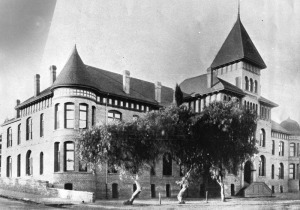 Harold’s corner stone wall, at Cleveland and Alpine, was up the street from the former Los Angeles Orphans Home that stood at the corner of Yale and Alpine. By 1913 the former orphanage was used as the headquarters to the Partido Liberal Mexicano (PLM), and was called La Casa del Obero Internacional, or International Workers Home, which offered lodging, community services, and cultural activities. The PLM was formed by brothers Ricardo and Enrique Flores Magón, who played an instrumental role in the Mexican Revolution (1910 – 1920), who settled in Los Angeles in 1910. A closer view of the former orphanage, once standing at 807 Yale Street, appears to the right (LAPL). According to the Los Angeles online building permits, the orphanage was demolished in 1917, and by 1919 was replaced with a one story garage. But its stone perimeter wall remained for Harold to play on.
Harold’s corner stone wall, at Cleveland and Alpine, was up the street from the former Los Angeles Orphans Home that stood at the corner of Yale and Alpine. By 1913 the former orphanage was used as the headquarters to the Partido Liberal Mexicano (PLM), and was called La Casa del Obero Internacional, or International Workers Home, which offered lodging, community services, and cultural activities. The PLM was formed by brothers Ricardo and Enrique Flores Magón, who played an instrumental role in the Mexican Revolution (1910 – 1920), who settled in Los Angeles in 1910. A closer view of the former orphanage, once standing at 807 Yale Street, appears to the right (LAPL). According to the Los Angeles online building permits, the orphanage was demolished in 1917, and by 1919 was replaced with a one story garage. But its stone perimeter wall remained for Harold to play on.

Behind Harold, the former Castelar Street School appears at back. LAPL.
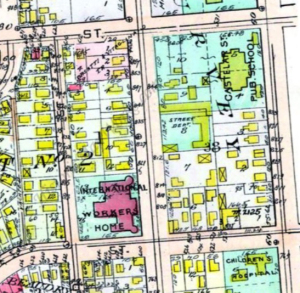 Harold’s orientation at the corner of Alpine and Cleveland also confirms that the back of the former Castelar Street School, that once stood at 851 Castelar, appears behind him in a different shot (above). Looking north, this 1914 map (left) shows the site of the International Workers Home, fronting Yale Street, and its relation to the Castelar Street School to the upper right. Harold filmed at the back corner of the home. The Castelar Elementary School still exists, but the main buildings now face Yale Street, with open grounds where the former school stood.
Harold’s orientation at the corner of Alpine and Cleveland also confirms that the back of the former Castelar Street School, that once stood at 851 Castelar, appears behind him in a different shot (above). Looking north, this 1914 map (left) shows the site of the International Workers Home, fronting Yale Street, and its relation to the Castelar Street School to the upper right. Harold filmed at the back corner of the home. The Castelar Elementary School still exists, but the main buildings now face Yale Street, with open grounds where the former school stood.

Looking west, this 1932 view shows Harold’s corner at Cleveland and Alpine in relation to the Castelar school. The words “Yale St” appear over the one story garage that replaced the orphanage in 1919. This stretch of Castelar Street is now called N. Hill Street.
Below, this circa 1928 aerial view shows Harold’s corner (oval) at Cleveland (red arrow) and Alpine, in relation to the back of the Castelar Street School.

Another view, looking north up Cleveland (arrow) from the corner of Alpine (oval). LAPL.

Two surviving buildings likely appear as shown.
In 1906 the west side of Cleveland was the site of a brick factory. At some point it shut down, and starting in 1910 several homes were moved from elsewhere to the street, including the 815 Lotito home, now lost, appearing to the far left of the movie frame. Christopher Lotito still owned the home in 1945 when some alteration work was done. The aerial photos and maps show that in 1919 a vacant lot stood between the Lotito home, and the prominent 823-825 duplex, now lost, identified above. Due north of this lost duplex, and thus directly behind it in the movie frame, stands the surviving 827-829 duplex, as likely identified above. The other surviving home, 837, two sites further north of the lost 823-825 duplex, has a peak on the left front of the house, and is also likely identified above.
More Harold news: I am excited to report that I will introducing Safety Last! at the Orpheum Theater on June 25, 2016 as part of the Los Angeles Conservancy’s Last Remaining Seats summer program. I’ve put together a fun program with many new discoveries, including a tie-in between Safety Last! and Clifton’s Cafeteria.
HAROLD LLOYD images and the names of Mr. Lloyd’s films are all trademarks and/or service marks of Harold Lloyd Entertainment Inc. Images and movie frame images reproduced courtesy of The Harold Lloyd Trust and Harold Lloyd Entertainment Inc.
Harold’s corner of Alpine and Cleveland today.
Filed under: Harold Lloyd Tagged: Alpine Street, Bumping Into Broadway, Castelar Street School, E.S. Onizuka Street, Harold Lloyd, La Casa del Obero Internacional, Partido Liberal Mexicano, Silent Comedians, Silent Comedies, Silent Movie Locations, Silent Movies, then and now, Yale Street

April 18, 2016
Buster in Cops Cruising Santa Monica Boulevard

Big Joe Roberts in Cops – suddenly realizing his wallet is missing.
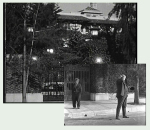 Buster Keaton’s famous short film Cops (1922) remains his only self-produced movie that was filmed completely out of doors, with no interior scenes. Early in the film Buster helps Big Joe Roberts into a taxi in front of the Pantages estate at 590 N.
Buster Keaton’s famous short film Cops (1922) remains his only self-produced movie that was filmed completely out of doors, with no interior scenes. Early in the film Buster helps Big Joe Roberts into a taxi in front of the Pantages estate at 590 N. 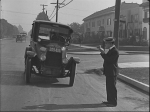 Vermont (shown HERE), while the scene where Joe leans out of the taxi window to retrieve his wallet from Buster, but not his cash, was filmed miles away at Sunset and Detroit (shown HERE).
Vermont (shown HERE), while the scene where Joe leans out of the taxi window to retrieve his wallet from Buster, but not his cash, was filmed miles away at Sunset and Detroit (shown HERE).

Looking east down Santa Monica Boulevard from Gower. LAPL.
The reaction shots of Joe inside the taxi were filmed driving east along Santa Monica Boulevard, past Gower, just a few blocks from the Keaton Studio.
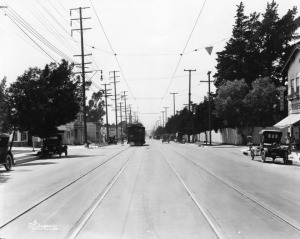 This Los Angeles Public Library view west down Santa Monica from Gower was taken near the time of filming, revealing the Warren Drug Co. that stood at the NW corner. The details match perfectly.
This Los Angeles Public Library view west down Santa Monica from Gower was taken near the time of filming, revealing the Warren Drug Co. that stood at the NW corner. The details match perfectly.
I discovered this scene when I noticed the prominent word “SODA” go by (see below), as a similarly prominent “SODA” sign appeared during a scene from Harold Lloyd’s 1921 comedy short I Do. The corner turned out to be the Warren Drug Co. on Santa Monica and Gower.

Matching words “SODA” appearing in Cops and in Harold Lloyd’s I Do.
True to form, Buster staged this scene just a few blocks away from his studio – see below.

Click to enlarge – the Keaton Studio at left (see enclosed barn-like shooting stage), at Eleanor and Lillian Way, just a few blocks west of the corner of Santa Monica and Gower, at left. Marc Wanamaker – Bison Archives.
In addition to Lloyd’s comedy I Do, the Warren Drug Co. also appeared during scenes from Larry Semon 1920 short The Suitor, see below. [Note: lacking access to these new photos, I incorrectly reported this corner in my Lloyd book Silent Visions as being one short block further east, at Beachwood, rather than at Gower.]

Lloyd in I Do, Larry Semon’s The Suitor, in front of the Warren Drug Co. HollywoodPhotographs.com

A 1938 view from the site of the demolished Keaton Studio, left, to Santa Monica and Gower. USC Digital Library.
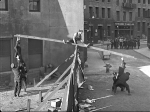 I have now identified every location appearing in Cops, including the stock footage of the policeman’s parade filmed in New York, and all but one of the many backlot shots, including the teeter-totter
I have now identified every location appearing in Cops, including the stock footage of the policeman’s parade filmed in New York, and all but one of the many backlot shots, including the teeter-totter  fence scene (shown HERE). The single remaining mystery is the studio backlot site for the final scene where Buster locks the gang of police within their own station house (at right). My sense is that it was filmed at the Metro lot due south of the Keaton Studio.
fence scene (shown HERE). The single remaining mystery is the studio backlot site for the final scene where Buster locks the gang of police within their own station house (at right). My sense is that it was filmed at the Metro lot due south of the Keaton Studio.

A similar view west in 1929. USC Digital Library.
You can read more about Cops in my book Silent Echoes, and in my many other posts about the film (see list HERE). A restored print of Cops will be presented this June 4, 2016 in San Francisco, as part of the annual San Francisco Silent Film Festival.
The corner of Santa Monica and Gower today.
Filed under: Buster Keaton, Cops Tagged: Buster Keaton, Cops, Gower, Harold Lloyd, I Do, Larry Semon, Santa Monica Boulevard, Silent Comedians, Silent Comedies, Silent Movie Locations, Silent Movies, The Suitor, then and now

March 21, 2016
Chaplin – Keaton Studio Connections – The Fireman and Convict 13

Looking south down Lillian Way from Eleanor towards the Vine Street Elementary School – Chaplin in The Fireman and Keaton (inset) in the same spot eight years later in Sherlock Jr. Their common studio stands off camera to the right.
Because Charlie Chaplin filmed his Mutual comedy shorts (1916-17) at the same small studio where Buster Keaton later filmed his independent shorts and features (1920-28), many common locations and settings appear in their films (see above). I explain this in great detail in my books, and in other posts, in part by deconstructing vintage aerial photographs looking south towards the studio that once stood at 1025 Lillian Way in Hollywood at the SW corner of Eleanor.

A 1920 view east of the Keaton and Metro Studios with Joseph W. Engel, Metro Studio General Manager (inset).
Chaplin’s The Fireman (1916) is particularly interesting, as he filmed a racing fire engine on many streets adjacent to the studio, some identified in my book, while others remained elusive, until now. A 1920 Hollywood publicity manual, Who’s Who On The Screen, ed. by Charles Donald Fox and Milton L. Silver, contains at pages 152-153 a rare eastern (not southern) aerial view of the studio, providing a novel vantage point that confirms not only several locations from The Fireman, but from Keaton’s early short comedies Convict 13 (1920) and The Playhouse (1921) as well. The HathiTrust uploaded the 1920 manual, containing hundreds of Hollywood star portraits and profiles, which may be viewed directly HERE. With the above overall aerial view looking east as a guide, this post reveals six new Chaplin and Keaton locations. You can click each image to enlarge it for a closer look.

In Chaplin’s The Fireman Leo White frantically telephones the fire department while standing on Eleanor mid-way between Cahuenga and Lillian Way. A trolley (yellow box) runs east along Santa Monica Blvd. (dotted line), while the distinctive single dormer home at 1062 Vine Street (red box) appears at back.
This same general view above also matches scenes from Keaton’s Convict 13 and The Playhouse.
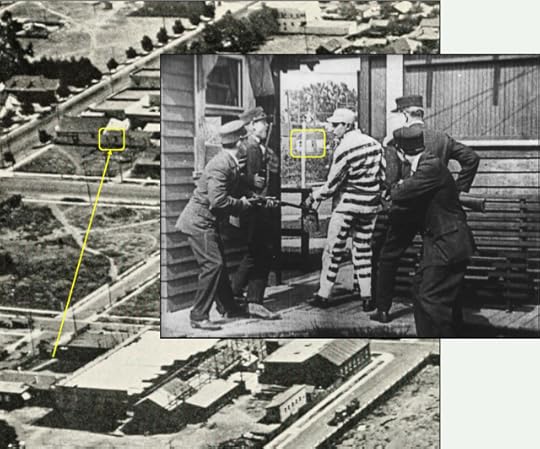
In Keaton’s Convict 13 the police question a painter about his paint-striped clothes at the gated entryway into the studio grounds. The back of the market at 6248 Santa Monica, east of Vine (yellow box), appears through the entrance.

In Keaton’s The Playhouse Buster invites a group of ditch-diggers to join his vaudeville show, while the market at 6248 Santa Monica Blvd. stands at back – barely a block from the studio in the foreground.

Returning to Convict 13, Buster runs south down Lillian Way by the studio office, with the shadow of Leo White’s telephone pole (blue), a car driving north up Vine (red box), and the homes at 6200 and 6206 Eleanor (yellow box) at back.
My book Silent Traces shows Chaplin filmed fire engine scenes near the studio on Lillian Way coming north towards Eleanor (see top of post), and going south down Cole from Willoughby, while filming other scenes at former Fire Station No. 29 at 158 S. Western Ave. Thanks to the ‘new’ aerial view looking east, and the clarity of the Blu-ray release of Chaplin’s Mutual Comedies, two further fire engine scenes are now evident.

In The Fireman, filmed in 1916, the wagon turns sharply from east on Willoughby to north on Cole (arrow), with 911 Cole (yellow box) standing watch.

Looking NW at the corner of Willoughby and Cole, with 917 Wilcox (left box), the only structure in this image to survive, apart from Yamashiro’s (inset) high on the hill at back.
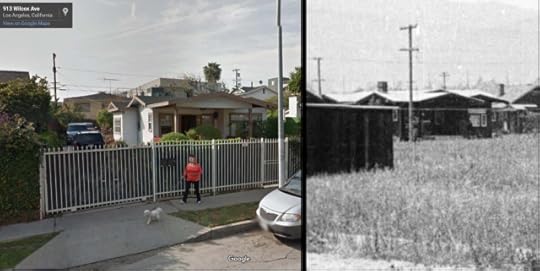
917 Wilcox – now and then – the chimney has been removed.
A final fire engine scene, this time looking east down Willoughby towards Cahuenga.

Filmed in 1916, this view looks east down Willoughby as the wagon turns south on Cahuenga.

This detailed view matches a 1922 aerial photo with the 1916 movie frame – 900 Vine Street (yellow box) stands at back.
I first became aware of the 1920 eastern view aerial photo on the Noirish Los Angeles Skyscraper forum, a remarkable resource for finding vintage images of Los Angeles. The forum not only highlights vintage photos from the Los Angeles Public Library, and the USC Digital Library, but also rare photos posted on eBay and other obscure sources. My thanks to Noirish forum posters ‘GaylordWilshire’ and ‘HossC’ for their assistance with this article.
Looking SE towards the corner of Lillian Way and Eleanor, site of the former Chaplin and Keaton Studios. A sidewalk plaque honoring Keaton, but neglecting to mention Chaplin, stands across the street on the near corner.
Filed under: Buster Keaton, Chaplin Studio, Charlie Chaplin, Keaton Studio Tagged: Buster Keaton, Chaplin Locations, Chaplin Studio, Charlie Chaplin, Convict 13, Keaton Locations, Keaton Studio, Sherlock Jr., Silent Comedians, Silent Movie Locations, Silent Movies, The Fireman, The Playhouse, then and now

March 6, 2016
How Mabel Normand filmed her Safety Last! Moment (Before Harold Lloyd Did)

Hold on – Mabel Normand clings to the roof of the Castle Towers Apartments in Mickey.
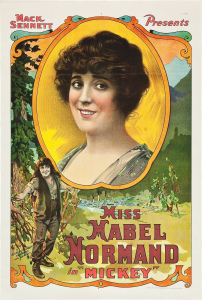 Mabel Normand’s wildly popular 1918 feature Mickey climaxes with a thrilling roof-top rescue staged years before Harold Lloyd stunned audiences with his high-rise climb in Safety Last! (1923). Reportedly the highest grossing film of the year, Mickey was the only film produced by Mabel’s independent studio set up for her by Mack Sennett. As shown in a prior post, Mabel’s early co-star Roscoe Arbuckle also beat Lloyd to the punch filming downtown rooftop stunts.
Mabel Normand’s wildly popular 1918 feature Mickey climaxes with a thrilling roof-top rescue staged years before Harold Lloyd stunned audiences with his high-rise climb in Safety Last! (1923). Reportedly the highest grossing film of the year, Mickey was the only film produced by Mabel’s independent studio set up for her by Mack Sennett. As shown in a prior post, Mabel’s early co-star Roscoe Arbuckle also beat Lloyd to the punch filming downtown rooftop stunts.
Mabel plays the lead, Mickey, a nature-loving tomboy forced to live with her cruel, aristocratic aunt. The movie brims with real locations, including the aunt’s formal gardens, filmed at 4 Berkeley Square (Hal Roach’s neighbor), where Lloyd and other Roach Studio stars would film posh garden scenes for later comedies, and the equestrian race track that once stood at Exposition Park (years before the Coliseum opened in 1923). I hope some day to post several more stories about Mickey.

Looks can be deceiving – seemingly matching wide and close views of Mabel’s rooftop climb?
This rooftop scene fascinated me, but I had no idea where it was located. Seeking help, I posted the above movie frames to share on Flickr, and within minutes Los Angeles historian and OnBunkerHill.org blogger Nathan Marsak contacted me to identify the setting as the former Castle Towers Apartments, once standing atop Bunker Hill at 750 W. 4th Street, on a bluff running parallel to Flower Street.

Mabel filmed using the Castle Towers. OnBunkerHill.org. Christina Rice.
Christina Rice, Los Angeles Public Library Senior Librarian, biographer of Ann Dvorak, and fellow OnBunkerHill.org blogger, wrote about the building’s incredible story (see more below), once belonging to prominent resident Mira Hershey. The chocolate family heiress and one-time owner of the famed Hollywood Hotel is perhaps best remembered as the benefactor of UCLA’s first on-campus dormitory Hershey Hall, that still bears her name.

The back of the Castle Towers which faced 4th Street where it ended at a bluff overlooking Flower Street. This detailed image is but a tiny portion of a giant sweeping panoramic image taken in 1930. USC Digital Library whit-neh-71421.
Given the off-kilter orientation of downtown (the streets run NW-SE and NE-SW, 45 degrees from true north), the orientation of the building along the Flower Street bluff means that the wide view (right below) runs SE towards the flat area of the LA basin. Since the wide view and close-up view of Mabel seem to match, the close-up view should also look to the SE where it is flat. Yet the close-up shot seems to look north to the Hollywood hills instead – how could this be?

I wondered – if the opposite corners of the building were identical, Mabel could have filmed her wide view to the right, and her close-up at the safer position to the left.
As Christina reports, the Castle Towers was originally the private home of Mira Hershey, facing Grand at the NE corner of 4th Street as shown below. Incredibly, in order to transform her home into an apartment building, Ms. Hershey had the home cut in two, rotated clockwise 90 degrees, moved two blocks west along 4th Street to beside the dead-end bluff above Flower Street, and extended by adding a new middle section with two further dormers along each side. At its new location and orientation, a view of its front left corner would look nearly due north towards Hollywood.
So what does this all mean? The answer is elegantly simple. As shown below, Mabel found a building with identical, opposite corner towers, one strikingly high off the ground, the other low to the ground, and presented the two towers as one and the same. In this way Mabel convincingly presented herself as in great danger while filming in relative safety.

When Mabel climbed from the roof to the window, she filmed at the front left corner that was only one story above the ground. This view shows the Hershey home at its original location at 4th and Grand before it was cut in half, moved two blocks, and expanded with two further dormers along each side. LAPL.
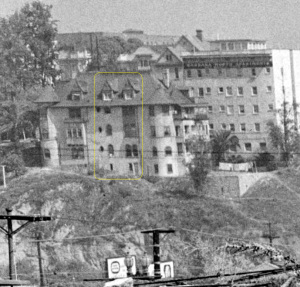
This rare side view of the apartment was taken in 1951 during the construction of the Harbor Freeway towards downtown. After the house was sliced in two sections, rotated, and moved to this location, it was converted into an apartment house with a new, extended middle section, marked by the yellow box. Behind it stands the former Barbara Worth Apartments.

Comparing a 1923 image of the hillside (left) – LAPL – to the 1930 photo, showing how the hillside along Flower Street was excavated, making way for a new building, gas station, and parking lot.
The history of Los Angeles and of the movies are inexorably intertwined. Thanks to Mabel, we now have further views of a Bunker Hill landmark to enjoy, while thanks to the archivists who make historic photos available, we can appreciate nearly 100 years later how remarkably clever Mabel and the other early filmmakers were. We are also indebted to Paul Gierucki, Brittany Valente, and CineMuseum, LLC for restoring Mickey, and to TCM for broadcasting it for eager viewers to enjoy.
A modern view looking up from Flower Street towards the former site of the Castle Towers Apartments.
Filed under: Bunker Hill Tagged: bunker hill, Castle Towers, Los Angeles Historic Core, Mabel Normand, Mickey, Mira Hershey, Silent Comedians, Silent Comedies, Silent Movie Locations, Silent Movies, then and now

March 2, 2016
Mostly Lost – Keaton Found (Stan Laurel too) at Hollywood and Western

From The Goat – Buster is about to push one cop to flatten another. Can you make out the number over the doorway? Neither could I. It’s 5501.
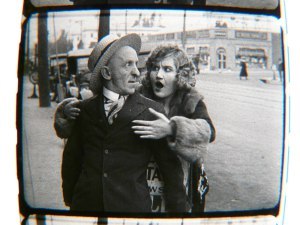
This fun discovery from Buster Keaton’s The Goat (1921) was made possible thanks to Mostly Lost, the Library of Congress crowd-sourcing workshop to screen and identify orphan silent and early sound films, held at the Packard Campus in Culpeper Virginia. Each year cinema experts from around the world gather to view rare film clips and pool
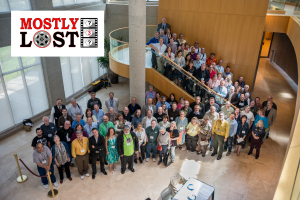
The friendly film experts at Mostly Lost 3.
their expertise with the hope of identifying them. The Goat, obviously, is an identified film, but the setting for the above scene, where Buster rounds a corner chased by one cop, and pushes another cop into his path, had eluded me for years. When released on Blu-ray, I was delighted (and frustrated) to see the hint of the numbers above the doorway where Buster stood. They were still undecipherable, but the four digit address meant it was likely filmed in Hollywood, and the sun implied it was a NW corner.
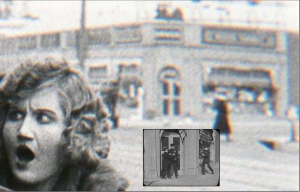 For some reason, when glancing through the Mostly Lost Nitrate Film Interest Group on Flickr, I came upon the above image of a bald man and shocked woman. While the film remains unidentified, I noticed the background corner doorway looked suspiciously like Buster’s (see inset). The image provided two essential clues – the corner was on a trolley line and stood east of a white three-story building.
For some reason, when glancing through the Mostly Lost Nitrate Film Interest Group on Flickr, I came upon the above image of a bald man and shocked woman. While the film remains unidentified, I noticed the background corner doorway looked suspiciously like Buster’s (see inset). The image provided two essential clues – the corner was on a trolley line and stood east of a white three-story building.
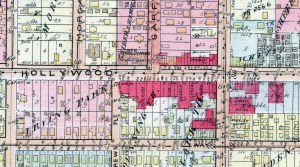
At right the NW corner of Hollywood and Western.
I studied many NW corners along trolley car lines but grew tired and had no luck. My breakthrough came when I realized the 1921 Baist color atlas for Los Angeles identified brick buildings in red and wooden structures in yellow. I traced the trolley lines along such maps looking only for red NW corners, and finding a limited number of candidates soon had my match.

Click to enlarge – looking west down Hollywood Blvd towards the corner of Western. LAPL.
When Buster filmed at the NW corner of Hollywood and Western, the New Hollywood Apartments, a white three story unit built in 1913 stood to the west (red arrow above), now replaced by a modern building. The five story building (crossed out in yellow, above), not present in the movie frame, was built in 1926 and still stands at 5531 Hollywood Blvd. Below, a closer look at the NW corner at 5501.

Click to enlarge – looking north up Western towards 5501 Hollywood Blvd. LAPL.
While Buster had his NW corner, it turns out Stan Laurel filmed the SE corner here in 1923 for one of his early Hal Roach Studios solo comedies, Mother’s Joy, looking east down Hollywood Blvd. from Western. The intersecting trolley tracks below, a rarity in Hollywood, helped to solve this location. The distinctive buildings behind Stan appear at the left edge of this matching photo looking west down Hollywood Blvd.

Looking east down Hollywood Blvd. from Western. Stan Laurel in Mother’s Joy. LAPL.
For better or worse, the intersection of Hollywood and Western has been completely redeveloped, so nothing remains today from Buster and Stan’s films. But thanks to Mostly Lost they are ‘somewhat’ found.
A Google maps view of Buster’s NW corner on Western.
A Google Maps view of Stan’s SE corner on Western.
Filed under: Buster Keaton, Stan Laurel, The Goat Tagged: Buster Keaton, Hollywood, Hollywood Boulevard, Hollywood Tour, Keaton Locations, Library of Congress, Mostly Lost, Mother's Joy, Silent Comedians, Silent Comedies, Silent Movie Locations, Silent Movies, Stan Laurel, The Goat, then and now, Western Avenue

February 14, 2016
The Kid – Charlie Chaplin’s Onscreen Fans

Click to enlarge. A delighted girl peeks through a screen door during The Kid.
While Chaplin fans packed theaters worldwide to watch his onscreen antics, during several scenes in The Kid you can see fans watching him onscreen as well. Here are several surprise fan cameos, thanks to the remarkable image quality of the new Criterion Collection Blu-ray release of The Kid. My recent post HERE shows how Chaplin made The Kid, which I explain in full detail in my book Silent Traces.

This neighbor suddenly peeks over the fence as the orphanage truck travels west down Labory Lane.

Shielding his eyes from the sun, this real-life waif watches Jackie Coogan in the orphanage truck as it turns from the east end of Labory Lane onto Hewitt.

Two girls are seen here as Dan Dillon returns the foundling baby to Minnie Stearns’ stroller.
Fans made cameos in other early Chaplin films. Thanks to the Blu-ray quality of the Flicker Alley release of Chaplin’s Essanay comedies, here below you can see a bystander through the window (notice his hat) during the opening scene from The Bank (1915).

We’re watching Charlie, and so is the man in the hat, watching him through the window in The Bank.
Filed under: Charlie Chaplin, The Kid Tagged: Chaplin Locations, Charlie Chaplin, Silent Comedians, Silent Comedies, Silent Movie Locations, Silent Movies, The Kid, then and now

February 1, 2016
Chaplin on South Central – Making It Work

Charlie Chaplin on South Central Avenue in Work (1915).
This image of Charlie Chaplin struggling with a cart load of tools and supplies in a Dickensian warehouse district is one of the most visually arresting of his entire career. Surrounded by horse-drawn wagons and early automobiles, the Little Tramp seems stuck in some chronological limbo, straddling the Victorian era and the impending Jazz Age. Taken over 100 years ago for the movie Work, the gritty street image always fascinated me, but it seemed beyond reach, never to be understood. But thanks to the clarity of the wonderful restored Blu-ray release of Chaplin’s Essanay comedies from Flicker Alley, this elusive setting quickly revealed itself.
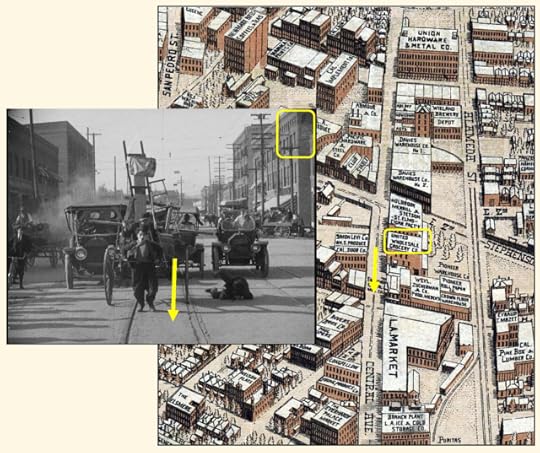
Charlie’s path in 1915 past the United Wholesale Grocery Co. as shown on this 1908 “bird’s eye” view map of downtown Los Angeles. The tall building to the left behind Chaplin was built after 1908 and thus does not appear on this map.
As Charlie moves down the street, we can briefly glimpse a painted wall sign at back that says “UNITED W– GROC–” By checking the Los Angeles City Directories available online at the Los Angeles Public Library, out popped the likely candidate, the United Wholesale Grocery Co. that once stood at 216 S Central Avenue. While not the most photographed part of town, comparing the site with vintage maps and a long-range aerial view confirms Charlie filmed walking south down Central from 2nd towards 3rd.

Click to enlarge. A matching aerial view of the block – Central running left-right between 3rd St at left and 2nd St at right. The gap between the buildings is due to a rail spur crossing the avenue. LAPL.
The orange oval above marks 219-227 S Central, once home to the Ducommun Corporation, the yellow oval marks the United Wholesale Grocery Co. The gap between the buildings accommodates a rail spur line that once crossed Central in the middle of the block. The brick warehouses were all demolished in the late 1970s.

The Bradbury Mansion studio on Court Hill, upper left, and the filming site, lower right. This 1908 map shows only one bore for the Hill Street Tunnel under Court Hill – the second bore, for automobiles, was completed in 1913.
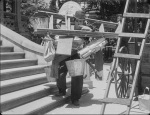
On the steps of the Bradbury Mansion
As discussed in my book Silent Traces, and in other posts, Chaplin filmed Work at the Bradbury Mansion studio atop Court Hill, the same studio where Harold Lloyd and producer Hal Roach started their careers at about the same time. The Bradbury Mansion front steps, and the Hopperstead house
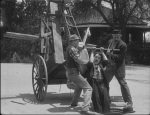
At back the Hopperstead home.
standing on the opposing corner from the mansion, both appear during Chaplin’s film. The warehouse street setting stood less than a mile away, quickly reached by taking 1st Street from Court Hill a few blocks east to Central, and turning south for two blocks.
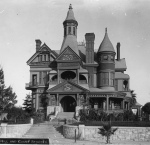
The Bradbury Mansion. USC Digital Library.
Thanks to preservationist Serge Bromberg of Lobster Films, and Cineteca di Bologna, all 15 of Chaplin’s Essanay short comedies from 1915 are now beautifully restored, available as a 5 disc Blu-ray/DVD box set from Flicker Alley.
Special Contents of Chaplin’s Essanay Comedies (C) 2015 by Lobster Films for the Chaplin Project. Work Blu-ray Publication and Design (C) 2015 Flicker Alley, LLC.
All images from Chaplin films made from 1918 onwards, copyright © Roy Export Company Establishment. CHARLES CHAPLIN, CHAPLIN, and the LITTLE TRAMP, photographs from and the names of Mr. Chaplin’s films are trademarks and/or service marks of Bubbles Incorporated SA and/or Roy Export Company Establishment. Used with permission.
A matching view looking north up S Central today – nothing remains.
Filed under: Charlie Chaplin, Court Hill, Los Angeles Historic Core Tagged: Chaplin Tour, Charlie Chaplin, Essanay, Los Angeles Historic Core, Silent Comedians, Silent Comedies, Silent Movie Locations, Silent Movies, South Central, then and now, Work

January 8, 2016
How Charlie Chaplin filmed The Kid
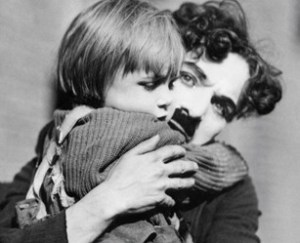
Coogan and Chaplin on Olvera Street
Filmed mostly in 1920, The Kid utilizes more historic settings and extant locations than any other Chaplin film. 95 years later you can still visit Edna Purviance’s Dickensian maternity ward, the mansion (later owned by Muhammad Ali) where she abandons her baby, and the Hollywood alley where Charlie first encounters the abandoned child. To celebrate the Criterion Collection’s Blu-ray release of The Kid, this post provides a broad overview of the film.
The Kid remains my favorite film – it best harmonizes Chaplin’s themes with real-life settings – at the downtown plaza, where Hispanic descendants from California’s former ruling class found themselves ostracized in their own home, and in nearby Chinatown, where restrictive laws and immigration policies kept descendants of Chinese railroad laborers from owning property or sending home for family members. Alienation and adversity echo from the very bricks and stones where Chaplin chose to shoot. That many of these places still exist after 95 years is a small miracle. You can read much more about these and many other settings from the film in my Chaplin book Silent Traces. There are also many related posts on my blog.
All images from Chaplin films made from 1918 onwards, copyright © Roy Export Company Establishment. CHARLES CHAPLIN, CHAPLIN, and the LITTLE TRAMP, photographs from and the names of Mr. Chaplin’s films are trademarks and/or service marks of Bubbles Incorporated SA and/or Roy Export Company Establishment. Used with permission.
The filming site on Olvera Street.
Filed under: Charlie Chaplin, The Kid Tagged: Chaplin Tour, Charlie Chaplin, Silent Comedians, Silent Comedies, Silent Movie Locations, Silent Movies, The Kid, then and now

December 29, 2015
How Roscoe Arbuckle Filmed His Safety Last! Moment (Before Harold Lloyd Did)
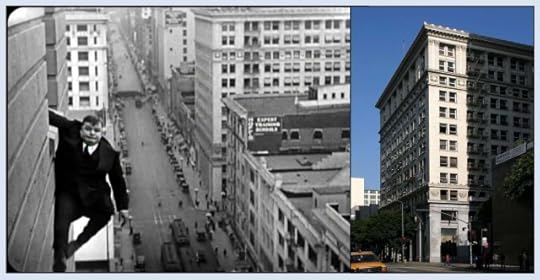
Looking up Spring Street, Roscoe Arbuckle hangs from the Bartlett Building rooftop in The Life of the Party. At back, the Merchants National Bank Building at the NE corner of 5th. You-Are-Here.Com
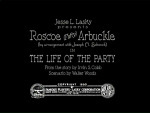 Early in Roscoe Arbuckle’s charming feature comedy The Life of the Party (1920), his character, instantly smitten by a female visitor to his high-rise law offices, stumbles
Early in Roscoe Arbuckle’s charming feature comedy The Life of the Party (1920), his character, instantly smitten by a female visitor to his high-rise law offices, stumbles 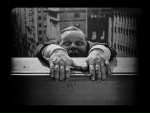 backward through an open window, and hangs precipitously several stories in the air. Though not integral to the plot, Roscoe’s brief scene presages Harold Lloyd’s later stunt climbing work in downtown Los Angeles, and has a direct connection with Lloyd’s masterpiece Safety Last! (1923).
backward through an open window, and hangs precipitously several stories in the air. Though not integral to the plot, Roscoe’s brief scene presages Harold Lloyd’s later stunt climbing work in downtown Los Angeles, and has a direct connection with Lloyd’s masterpiece Safety Last! (1923).

Click to enlarge – Roscoe in TLOTP and Harold in Safety Last! one block further up the street atop the Merchants National Bank Building, prominent in Roscoe’s frame (Lloyd’s approximate location is marked by the gray box). Both views show the side building signs for the Alexandria Hotel (yellow box) and the Security Trust and Savings Bank (red box).
Roscoe filmed his stunt atop the stepped-back terraced roof of the extant Bartlett Building, built in 1911 at 215 W. 7th Street, in the heart of the Los Angeles historic core, converted now to condos and lofts. Behind Roscoe, visible up the street, stands the extant Merchants National Bank Building (now also condos and lofts) at 548 S. Spring Street. Harold Lloyd built a set atop the Merchants Bank to stage the final (and highest) segment of his climb up a skyscraper in Safety Last!
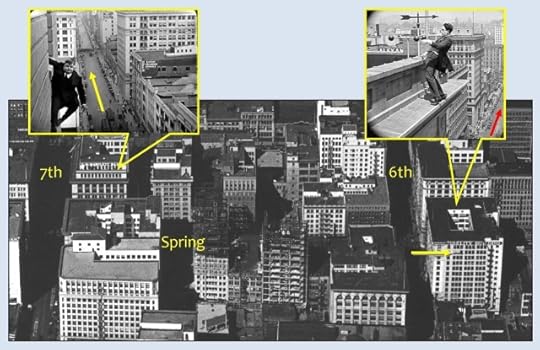
Click to enlarge – looking west at Spring Street between 7th and 6th. The yellow arrows point up Spring from 6th, the red arrow points up Spring from 5th.
Lloyd filmed a total of five stunt climbing comedies: Look Out Below (1919), High and Dizzy (1919), Never Weaken (1921), Safety Last!, and Feet First (1930). The first three were filmed using sets overlooking the Hill Street Tunnel (see post HERE), while Never Weaken went further, staging scenes filmed atop the extant Ville de Paris Department Store building at the SE corner of 7th and Olive. Thus, when Roscoe filmed TLOTP during April 15 – May 22 of 1920, he filmed in downtown, on a real building, more than a year before Harold did. You can read a list of the 15 real buildings (13 are still standing) that appear in Harold’s stunt films at this PDF link.

Click to enlarge – this view from the finale to Safety Last! looks south down Spring from 6th towards the Bartlett Building (Union Oil) terrace where Roscoe filmed (inset – his frame is reversed to aid comparison). The tall Los Angeles Stock Exchange Building began construction in 1921, after TLOTP had finished shooting – hence, it does not appear in Roscoe’s shot.
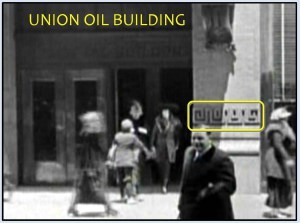 The establishing shot of Roscoe was filmed at the 7th Street entrance to the Bartlett Building, also known at the time as the Union Oil Building, its primary tenant. You can barely read “Union Oil Building” over the door, as well as the bottom edges of the numerals “215” (see below).
The establishing shot of Roscoe was filmed at the 7th Street entrance to the Bartlett Building, also known at the time as the Union Oil Building, its primary tenant. You can barely read “Union Oil Building” over the door, as well as the bottom edges of the numerals “215” (see below).

Click to enlarge – matching details of the Bartlett Building (Union Oil) entrance at 215 W. 7th Street compared to 1933 photos of what was then the entrance to the Security-First National Bank. USC Digital Library.

The lower floors of the Bartlett Building were given an Art Deco upgrade in 1937. This Bing Maps view shows the entrance today – the Art Deco facade now has a further “upgrade.”
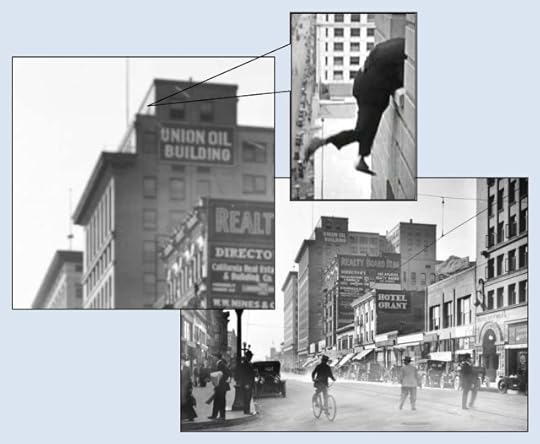
Looking south down Spring from 6th towards the Bartlett Building (Union Oil) rooftop filming site. This view more closely matches the street at the time of filming, taken before the tall Los Angeles Stock Exchange Building was completed in 1921 to the right of the Bartlett. USC Digital Library.

A modern view south down Spring towards the Bartlett Building filming site and the Stock Exchange Building next door to the right. Jeffrey Castel De Oro.
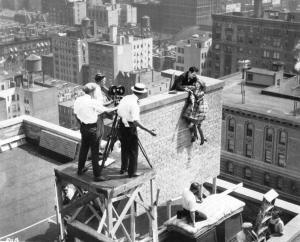
This simple setup is all it takes to convincingly portray a person in peril at great height, without using CGI.
Roscoe’s stunt scene could be easily recreated today from the same rooftop. I often wonder why this simple and highly effective shooting technique, more convincing than CGI, is not used in modern films.
We are all indebted to Paul Gierucki, Brittany Valente, and CineMuseum, LLC for restoring The Life of the Party
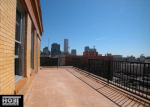
View from the Bartlett deck (reversed for comparison)
so beautifully, and to TCM for broadcasting it for eager viewers to enjoy.
I have many other posts about Safety Last! you can view here. HAROLD LLOYD images and the names of Mr. Lloyd’s films are all trademarks and/or service marks of Harold Lloyd Entertainment Inc. Images and movie frame images reproduced courtesy of The Harold Lloyd Trust and Harold Lloyd Entertainment Inc.
The Bartlett Building today, at the NW corner of 7th and Spring.
Filed under: Harold Lloyd, Los Angeles Historic Core, Roscoe Arbuckle, Safety Last! Tagged: Bartlett Building, Harold Lloyd, Lloyd Thrill Pictures, Los Angeles Historic Core, Safety Last!, Silent Comedians, Silent Comedies, Silent Movie Locations, Silent Movies, The Life of the Party, then and now

December 19, 2015
Houdini – The Grim Game – More Hollywood Connections

Click to enlarge. The site of The Grim Game plane crash was the staged at the Famous Players – Lasky Studio backlot. Shown here moments before the crash, the house to the left in the movie frame (left) has a chimney on each end, while the central house has three dormer windows, matching the backlot sets (box). Bison Archives.
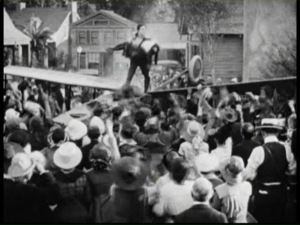
Houdini triumphantly survives the crash
The climax to Harry Houdini’s debut feature film The Grim Game (1919) involved the real-life mid-air collision of two airplanes captured on film (discussed in my prior post HERE). The extraordinary footage was worked into the story by filming the supposed crash landing of each plane, created by dropping prop planes, suspended nose down out of camera range, onto the ground. I had no idea where this sequence was filmed, until I happened to glance at a large aerial photo of the Famous Players – Lasky Studio, that once stood on Selma and Vine. I noticed that two homes on the studio 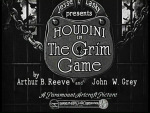 backlot photograph looked familiar, then suddenly remembered that Lasky had produced Houdini’s film. A quick check with the movie confirmed the obvious – the crash was staged at the backlot of the studio producing the film.
backlot photograph looked familiar, then suddenly remembered that Lasky had produced Houdini’s film. A quick check with the movie confirmed the obvious – the crash was staged at the backlot of the studio producing the film.
This revelation solved another mystery. In my first post about The Grim Game I reported that Houdini filmed a brief scene at a Hollywood alley that Buster Keaton would use a few years later in Cops (see below). Why was Houdini’s simple scene filmed at this spot? The answer lies with the Famous Players – Lasky Studio.

Houdini filmed a brief scene at the Cahuenga alley just south of Hollywood Blvd. where Buster filmed this famous stunt from Cops. The tall Palmer Building, undergoing construction behind Buster, still stands on Cosmo Street.
As shown below, the plane crash site at the studio backlot was barely two blocks east of the alley on Cahuenga! In 1919 this alley was both close by, but also rather unique, as there were few other commercial buildings in town at the time. Following Houdini’s lead, Buster Keaton (Neighbors, Cops), Charlie Chaplin (The Kid), and Harold Lloyd (Never Weaken, Safety Last!), would all later film at this convenient alley.
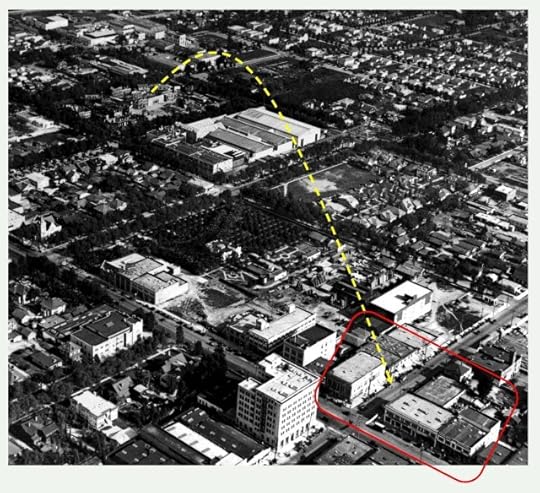
The backlot plane crash site stood barely two blocks from the alley on Cahuenga where Houdini filmed (arrow). This photo was taken in 1922. At the time Houdini filmed in 1919 many buildings outside of the red box were not built yet, and the alley was fairly unique. Bison Archives.
This broader view of the studio (below) shows the backlot homes (box), and “The Barn” standing on the corner of Selma and Vine.

The backlot at top, and “The Barn” standing at Vine and Selma, now home to the Hollywood Heritage Museum.
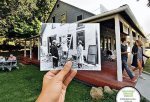
The Barn Today – Hollywood Heritage.
Built in 1901, the Lasky – De Mille Barn that stood at Vine and Selma became home to the Jesse L. Lasky Feature Play Co. in 1913, where the company’s first feature film The Squaw Man was co-directed by Cecile B. De Mille in 1914. Lasky merged with Adolph Zukor’s Famous Players Film Co., creating the Famous Players – Lasky Studio, that would later become Paramount Pictures Corporation. When Paramount relocated to its present site on Melrose Avenue, “The Barn” was relocated there too, where it served for many years as a gymnasium and location set. The Barn was donated to the Hollywood Heritage Museum, and now sits at 2100 N. Highland Avenue in the parking lot across from the Hollywood Bowl. In 2014 the Lasky-DeMille Barn was listed on the National Register of Historic Places.
Filed under: Cops, Harry Houdini, The Grim Game Tagged: Buster Keaton, East Cahuenga Alley, Harry Houdini, Hollywood, Silent Movie Locations, Silent Movies, The Grim Game, then and now



